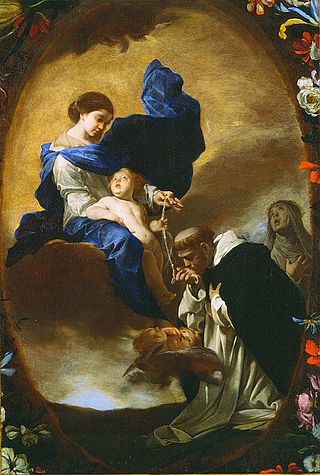
The Rosary, also known as the Dominican Rosary, refers to a set of prayers used primarily in the Catholic Church, and to the physical string of knots or beads used to count the component prayers. When referring to the prayer, the word is usually capitalized ; when referring to the prayer beads as an object, it is written with a lower-case initial letter.

The Scapular of Our Lady of Mount Carmel belongs to the habit of both the Carmelite Order and the Discalced Carmelite Order, both of which have Our Lady of Mount Carmel as their patroness. In its small form, it is widely popular within the Latin Church of the Catholic Church as a religious article and has probably served as the prototype of all the other devotional scapulars. The liturgical feast day of Our Lady of Mount Carmel, July 16, is popularly associated with the devotion of the Scapular.

Catholic Mariology is Mariology in Catholic theology. According to the Immaculate Conception taught by the Catholic Church, she was conceived and born without sin, hence Mary is seen as having a singular dignity above the saints, receiving a higher level of veneration than all angelic spirits and blessed souls in heaven. Catholic Mariology thus studies not only her life but also the veneration of her in daily life, prayer, hymns, art, music, and architecture in modern and ancient Christianity throughout the ages.
An apostolic constitution is the most solemn form of legislation issued by the Pope.

The Sodality of Our Lady, also known as the Sodality of the Blessed Virgin Mary, is a Roman Catholic Marian society founded in 1563 by young Belgian Jesuit Jean Leunis at the Roman College of the Society of Jesus. The modern Ignatian lay group Christian Life Community traces its origins to the first Sodality.
Munificentissimus Deus is the name of an apostolic constitution written by Pope Pius XII. It defines ex cathedra the dogma of the Assumption of the Blessed Virgin Mary. It was the first ex-cathedra infallible statement since the official ruling on papal infallibility was made at the First Vatican Council (1869–1870). In 1854 Pope Pius IX made an infallible statement with Ineffabilis Deus on the Immaculate Conception of the Virgin Mary, which was a basis for this dogma. The decree was promulgated on 1 November 1950.

The Congregation of Marian Fathers of the Immaculate Conception of the Most Blessed Virgin Mary is a Catholic male clerical religious congregation founded, 1670, in Poland. It is also known as Marians of the Immaculate Conception. Its members add the post-nominal letters M.I.C. after their names to indicate membership in the Congregation.
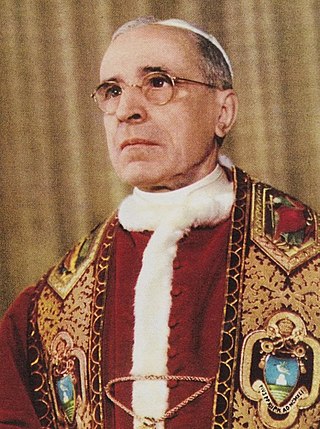
The late years of the pontificate of Pope Pius XII were characterized by a hesitancy in personnel decisions. After a major illness in 1954, he redirected his energies from Vatican clergy to the concerns of lay people.

Ad Caeli Reginam is an encyclical of Pope Pius XII, given at Rome, from St. Peter's Basilica, on the feast of the Maternity of the Blessed Virgin Mary, the eleventh day of October, 1954, towards the end of the Marian year, in the sixteenth year of his Pontificate. The encyclical is an important element of the Mariology of Pope Pius XII. It established the feast Queenship of Mary.

Fulgens corona is an encyclical by Pope Pius XII, given at St. Peter's, Rome, on 8 September 1953, the Feast of the Nativity of the Blessed Virgin Mary, in the fifteenth year of his Pontificate. The encyclical proclaims a Marian year for 1954, to commemorate the centenary of the definition of the dogma of the Immaculate Conception of the Virgin Mary.

The theology of Pope Pius XII is reflected in his forty-one encyclicals, as well as speeches and nearly 1000 messages, during his almost 20-year pontificate. The encyclicals Mystici corporis and Mediator Dei advanced the understanding of membership and participation in the Catholic Church. The encyclical Divino afflante Spiritu began opening the door to historical-critical biblical studies. But his magisterium was far larger and is difficult to summarize. In numerous speeches Catholic teaching is related to various aspects of life, education, medicine, politics, war and peace, the life of saints, Mary, the mother of God, things eternal and temporal.

The history of Catholic Mariology traces theological developments and views regarding Mary from the early Church to the 21st century. Mariology is a mainly Catholic ecclesiological study within theology, which centers on the relation of Mary, the Mother of God, and the Church. Theologically, it not only deals with her life but with her veneration in life and prayer, in art, music, and architecture, from ancient Christianity to modern times.

The Mariology of the popes is the theological study of the influence that the popes have had on the development, formulation and transformation of the Roman Catholic Church's doctrines and devotions relating to the Blessed Virgin Mary.
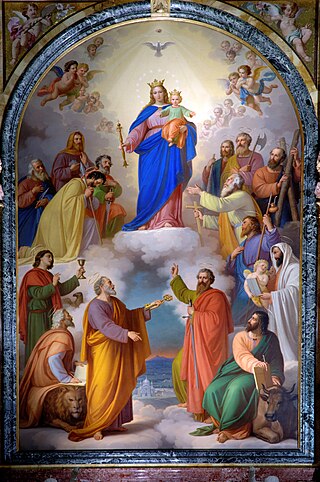
Mary, the Help of Christians, is a Roman Catholic title of the Blessed Virgin Mary, based on a religious devotion now associated with a feast day of the General Roman Calendar on 24 May.
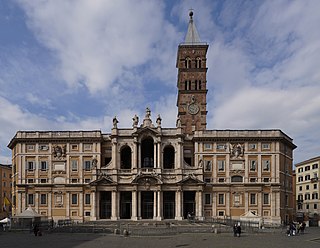
Catholic Marian churches are religious buildings dedicated to the veneration of the Blessed Virgin Mary. These churches were built throughout the history of the Catholic Church, and today they can be found on every continent including Antarctica. The history of Marian church architecture tells the unfolding story of the development of Catholic Mariology.
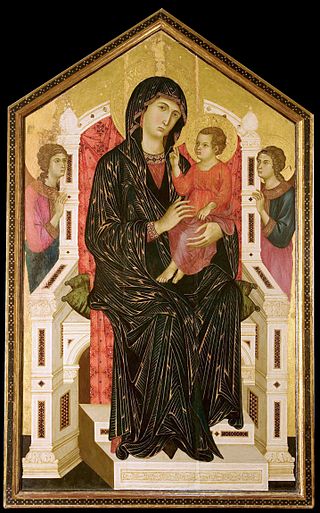
Mariological papal documents have been a major force that has shaped Roman Catholic Mariology over the centuries. Mariology is developed by theologians on the basis not only of Scripture and Tradition but also of the sensus fidei of the faithful as a whole, "from the bishops to the last of the faithful", and papal documents have recorded those developments, defining Marian dogmas, spreading doctrines and encouraging devotions within the Catholic Church.

Le pèlerinage de Lourdes is the only encyclical of Pope Pius XII issued in French. It includes warnings against materialism on the centenary of the apparitions at Lourdes. It was given at Rome, from St. Peter's Basilica, on the feast of the Visitation of the Most Holy Virgin, July 2, 1957, the nineteenth year of his pontificate.

Catholic Marian movements and societies have developed from the veneration of the Blessed Virgin Mary by members of the Catholic Church. These societies form part of the fabric of Mariology in the Catholic Church. Popular membership in Marian organizations grew significantly in the 20th century, as apparitions such as Our Lady of Fátima gave rise to societies with millions of members, and today many Marian societies exist around the world. This article reviews the major Marian movements and organizations.

The consecration and entrustment to the Virgin Mary is a personal or collective act of Marian devotion among Catholics, with the Latin terms oblatio, servitus, commendatio and dedicatio being used in this context. Consecration is an act by which a person is dedicated to a sacred service, or an act which separates an object, location or region from a common and profane mode to one for sacred use. The Congregation for Divine Worship and the Discipline of the Sacraments clarifies that in this context, "It should be recalled, however, that the term "consecration" is used here in a broad and non-technical sense: the expression is use of 'consecrating children to Our Lady', by which is intended placing children under her protection and asking her maternal blessing for them".

Our Lady of Arabia is a Catholic title of the Blessed Virgin Mary holding a Rosary and the Child Jesus as venerated in Kuwait and Bahrain by its faithful devotees. Under this venerated Marian title, she is designated as the patroness of the Apostolic Vicariates of Northern and Southern Arabia.


















